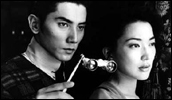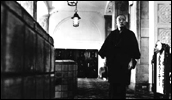Rampo
- Year
- 1994
- Original title
- Rampo
- Japanese title
- RAMPO
- Alternative title
- The Mystery of Rampo
- Director
- Cast
- Running time
- 140 minutes
- Published
- 3 October 2001



by Jasper Sharp
Sexy, fantastic, vivid, subversive - for over 60 years the collected works of the writer Edogawa Rampo, Japan's celebrated master of mystery fiction, have enjoyed a persistent run of success in Japan. In print, on screen, and even on stage, as in Yukio Mishima's 1956 adaptation of Black Lizard / Kurotokage (later subject to two big screen adaptations, firstly by Umetsugu Inoue in 1962 with Rashomon's Machiko Kyo in the title role, and Kinji Fukasaku's better known rendition in 1968).
Born Taro Hirai, the son of a merchant-lawyer, Rampo (1894-1965) spent the best part of his youth avidly feeding his fertile imagination with the writings of such notable Western practitioners of the detective story as Sir Arthur Conan Doyle and Maurice Leblanc, newly translated as Japan opened itself up to the rest of the world during the Meiji Restoration at the turn of the 20th century. When it finally came to putting the fruits of his own fervent imagination down in print with the 1923 short story The Two-Sen Copper Coin / Nisen Doka, he settled for the phonemic approximation of the name of one of his literary heroes, Edgar Allan Poe, as his nom de plume.
Rampo's acclaim in the English language for a long time lay pretty much exclusively with Japanese Tales of Mystery and Imagination, an anthology of short horror stories first translated in 1956. The limited number of film adaptations of his writing released outside of Japan have similarly been oriented around his more horrifically perverse works - The Blind Beast (1969 - Yasuzo Masumura), The Horror of Malformed Men (Kyofu Kikei Ningen, 1968 - Teruo Ishii), Watcher in the Attic (Yaneura no Sanposha, 1976 - Noboru Tanaka) and Gemini (Soseiji, 1999 - Shinya Tsukamoto).
However, peeping toms, sightless psychopathic sculptors, and deadly doppelgängers actually make up a rather small part of Rampo's fiction, and in his homeland he is remembered more for his detective fiction - predominantly featuring the dashing master of logic and disguise, detective Kogoro Akechi - and his later The Boys Detective Club (Shonen Tanteidan) series of children's books, about an agency of amateur juvenile detectives who featured in a number of films for Toei during the 1950s and a long running TV series during the 60s.
Biopics about writers are notoriously difficult to pull off. After all, there is nothing intrinsically dramatic about watching someone huddled over a typewriter pouring out their soul. There's not a lot of mileage in Hirai's real-life struggle to get into print either, his initial journey towards literary success marked out by a long string of dead end jobs and a brief spell looking after a friend's second-hand bookshop that went bust under his (mis-) management.
This was the problem Rintaro Mayazumi faced when he was first slated to direct the film based on Rampo's life to be released in the year of the writer's centenary in 1994. The year also coincided with the 100th anniversary of the Shochiku Corporation, so there was a lot riding on the production. When Mayuzumi turned in his version, the film's producer Kazuyoshi Okuyama thought the piece lacked a little oomph for such a high-profile cinematic event, so promptly ousted him from the directorial chair and re-shot 70% of it.
Taking the story The Appearance of Osei (Osei Tojo) as its starting point, The Mystery of Rampo is not so much a cinematic reconstruction of the author's life - though by using a number of props such as a hat and a box of matches that actually belonged to the author, it certainly makes bold claims to period detail. Nor is it a straightforward adaptation of Rampo's source novel. Instead it takes upon its shoulders the rather ambitious task or putting the author's work into a historical context in order to portray the conditions which gave rise to the author's unique output. It is also an attempt to delve into the very soul of the author to get to the heart of what exactly it was that made his work so enduringly resonant with the general public.
The fact is, in his day Rampo was really not well regarded by the literary establishment, who regarded his work as mere pulp fodder for the masses. The government at the beginning of the Showa period weren't too keen on it either, objecting to the "aberrant moral content" found in such spinechilling short stories as The Caterpillar (Imomushi) and The Red Chamber (Akai Heya). A number of these works were banned outright by the state censors, including The Appearance of Osei, leading Rampo to withdraw from creative writing for a couple of years. During this time he began work on his biography, in which he expressed his own disillusionment with the increasingly nationalistic and oppressive nature of Emperor Hirohito's Japan. History would of course bear him out over the next few decades.
"Rampo was a man who felt at odds with the times and departed from it by creating his own world", Okuyama stated at the time of the film's release. The Mystery of Rampo takes a speculative peak inside the writer's mind during the time when his work was increasingly falling foul of the censors. After an animated rendition of The Appearance of Osei's basic set up - that of a mysterious woman who locks her ailing husband in an antique chest and leaves him to suffocate - we see a rather sullen looking Rampo (the ever-reliable Naoto Takenaka) being hauled up in front of a government representative who orders his latest work to be destroyed. Rampo mopes back home and puts a match to the only existing copy of the offending manuscript, but shortly afterwards his editor shows him a newspaper clipping detailing a woman convicted of exactly the same offence.
Rampo is drawn into his own investigation, and tracks down the beautiful widow Shizuko (played by model Michiko Hada in her big screen debut) in the antiques shop that she ran with her deceased husband. Unable to reconcile the startling link between his unpublished novel and this eerie real life crime, he invokes his alter-ego, handsome Detective Akechi (Masahiro Motoki, who also starred in Tsukamoto's Gemini) in an attempt at bringing a fictional conclusion to these strange events. From this moment on we're immersed in a world of fantasy, where Shizuko is now playing mistress to the twisted Marquis Ogawara (Hira), a sadistic old pervert who seeks gratification by dressing up as his dead mother.
Mystery of Rampo was the talking point movie of 1994 in Japan, much of this down to the media-courting showmanship of its new director Kazuyoshi Okuyama. Despite taking the magnanimous step of releasing both versions of the film at the same time to allow audiences to decide which was the better, Mayazumi's version barely stood a chance against the bombast of publicity surrounding the new edit, and consequently it was Okuyama's version that caused the hubbub and was released throughout the rest of the world. Scenes such as an opulent celebrity party to which Rampo gives an address, featuring cameos from, among others, the directors Koji Wakamatsu and Kinji Fukasaku, highlight the "big is better" approach that is adopted throughout the entire exercise. Okuyama's film was more than just a homage to Rampo. It was a calculated cinematic event.
Okuyama makes ostentatious use of the full complement of state of the art cinematic techniques available to him at the time: animation, complicated optical effects, and innovative CGI technology. Despite such technology being then fairly much in its infancy and without the resources available to Hollywood filmmakers, this imagery not only integrates smoothly within the film's ambitious narrative, but also manages to bring a slick veneer to the look of the film without drawing attention to itself.
A scene in which the Marquis projects vintage pornographic film footage onto the naked body of his captive mistress, overlaying it with more and more erotic imagery to invoke the spiralling sense of delirium that lies at the heart of Rampo's potent prose fits in perfectly to the central conceit of using cinema as a means to investigating the various layers that exist between reality and fantasy. Its explicitness also managed to whip up further press coverage.
This daring collage of film styles and media (which also includes archival footage of Meiji-period Japan and clips taken from Susumu Yugi's 1954 three-part serialisation of Shochiku's early Detective Akechi story, The Fiend With Twenty Faces / Kaijin Niju Menso) fits in with the fragmentary approach to the narrative, in which the sum parts add up to more than their whole in the attempt to invoke the full force of Rampo's wildly fantastical imagination. The film is less interested in telling a straightforward story than in attempting to probe into the creative processes that gave rise to Rampo's flamboyantly grotesque fiction. Loft ambitions indeed, and Okuyama just about pulls it off.
Such an over-the-top approach seemed to meet a fairly successful reaction upon its Japanese release. In the rest of the world, however, Okuyama's cryptic approach to the subject matter was understandably met with slack-jawed bewilderment by those for whom the author's name meant next to nothing. Nevertheless, taken as a piece of pure cinema, The Mystery of Rampo is indeed an unrestrained visual extravaganza that is difficult to ignore, though rather tellingly, though Okuyama originally adopted to his new role in the director's chair with great gusto, he has subsequently stuck to production.